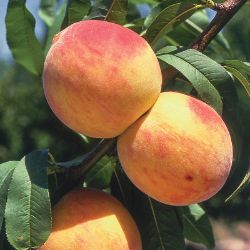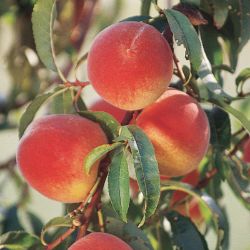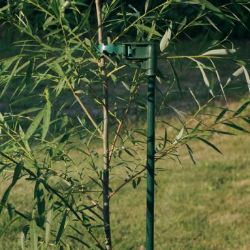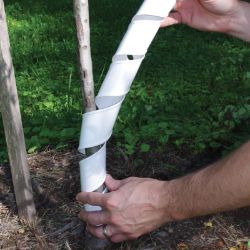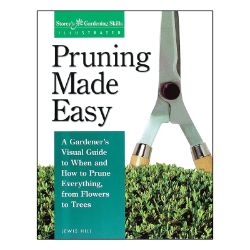Choosing a Location for Peach Trees
The best way to succeed: plan before you plant!
Let’s discuss location: Do you know where you want to plant your new peach trees? Avoid many future problems by considering all aspects of the planting spot, such as:
- Cross-pollination
- Sun and good soil
- The surroundings
- Proper spacing
- Consideration of future plantings
NOTE: This is part 3 in a series of 11 articles. For a complete background on how to grow peach trees, we recommend starting from the beginning.
Cross-Pollination
Most peach trees are self-pollinating; however, additional nearby peach trees (within 100 feet) of a different variety can improve fruit-set.
Almost all of Stark Bro’s peach trees are self-pollinating, meaning your mature tree will bear fruit without requiring another peach variety’s pollen. The only peach tree we sell that requires a pollinator is Stark® Hal-Berta Giant™, which can be pollinated with any other peach tree.
Peach trees are the ideal solution for small spaces, because in most cases they don’t require planting another peach tree for cross-pollination. Consider planting one of these popular self-pollinating peach trees:
Sun, Soil Type and Drainage
Peach trees thrive when growing in a location that receives full sun and has a well-drained, fertile soil. “Full sun” means at least 6 to 8 hours of sunlight each day during the growing season. Light is vital to fruit production and quality, and also helps keep fungal issues from taking hold. Remember this when choosing a location for your new peach trees.
Good soil drainage is necessary to keep a peach tree’s roots healthy, and healthy roots are the foundation of a healthy tree. If you find that your native soil is composed of heavy clay that retains water after rainy weather, you should choose a different site for your peach tree.
Conversely, if your site has fast-draining, sandy soil, then your peach tree may exhibit drought stress and may require more frequent watering. For your growing success, we do not recommend planting peach trees in either rocky or heavy, pure-clay soils. If you can’t plant elsewhere, you can try amending the soil prior to planting or planting in containers or raised garden beds.
Even if your yard isn’t the most ideal location, take heart. Peach trees can be very adaptable and they respond well to soil additives like compost or fertilizers, so they can get along well even where the soil is nutritionally poor.
Amending the soil greatly depends on your individual location, so communicating with your local county Cooperative Extension is a wise first step. In general — to help with water distribution — you can add coir, like our Coco-Fiber Growing Medium to your peach tree’s planting hole, or mix in one-third sphagnum/peat to the soil at planting time.
As an alternative to all of that digging, you can:
- Build a bottomless raised bed (at least 12 inches deep and at least 3 to 4 feet around).
- Plant your peach tree in a container. Repot your tree in a 5-gallon container, to start. You can “pot-up” peach trees into successively larger containers as the trees outgrow them.
Surroundings
Peach trees can also be a landscaping asset, so choose a planting site with this in mind. Imagine your young peach tree as full-grown, and think everything through:
- Are there utility wires or any other obstructions overhead?
- Are there underground cables, pipes, irrigation systems, utilities or other lines to avoid?
- Is there a sidewalk, driveway, or foundation within the range of your peach tree’s mature spread?
- Might your peach tree block the view of something you want to see once it’s fully grown?
- Will my neighboring trees be in the way or block sunlight from your apple tree as they grow?

Even a year or two after planting, a peach tree can be very difficult to successfully transplant, so take the time to plant it in the perfect place the first time around!
Space Wisely

Growers often ask about the recommended planting distances for peach trees to keep them away from patios, sewer lines, water pipes, etc. Ordinarily, patios will not be a problem because the soil beneath them is dry and compacted, and the roots will not be as encouraged to grow into this area. Conversely, sewer and water lines tend to be wet, which will encourage peach tree roots to grow toward them if planted too closely.
A smart distance is somewhere beyond your peach tree’s estimated maximum spread, which is roughly equal to the mature height of the peach tree you choose to plant. Our recommendations are below:
Space Between Trees:
- Dwarf: 8 to 10 feet apart
- Standard: 18 to 20 feet apart
- Columnar: 2 to 3 feet apart
- Miniature: 4 to 6 feet apart
Space for Future Plantings
If you’re new to planting peach trees, or you’re planting them in a new location, it’s wise to start with just a few. Later on, especially after you have reaped the rewards of growing your own peaches firsthand, you may want to expand your home orchard. Always err on the safe side and leave room for future peach trees, other fruit trees, berry plants, and other garden plants. You’ll be glad you did!















